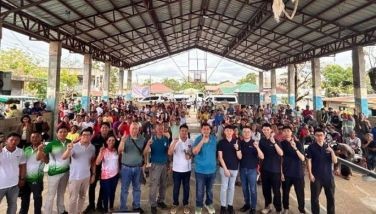A visit at Culion
October 24, 2005 | 12:00am
On Sunday afternoon, 27 May 1906, the first batch of lepers arrived in Culión. They were nearly 400 in number (365 came from the leper hospital in Cebu). They came in two ships. One man had died during the voyage. Many more would die on the island in the months and years to come.
On hand to welcome the lepers, besides the medical and administrative staff, was a Spanish Jesuit priest, Father Manuel Vallés, a veteran of the Mindanao missions. He had arrived in Culión two months earlier, in March 1906. He was to be joined in August by a Spanish Jesuit lay brother, Brother Ferrerons. Those two were the first in a long line of Jesuit priests and brothers who would serve the Culión community for the next one hundred years.
Also on hand to welcome that first batch of lepers were four French Sisters of St. Paul de Chartres, the first in a long line also of St. Paul Sisters who would serve Culión until today.
In the months and years ahead, more and more lepers would arrive, until the peak years just before World War II when Culión had more than 5,000 lepers, the largest leper colony in the world.
This year, from May 2005 till May 2006, Culión is celebrating its centenary. It also marks 100 years of Jesuit work on the island, as well as of the very devoted and brave St. Paul de Chartres Sisters.
During the Japanese Occupation, there was hunger in Culión because no food could come to the island. (The island is all mountain, with hardly any level land. All buildings are built into the slope.) Many lepers died. Many tried to escape in bancas, and were massacred by the Japanese either near Culión, or in the islands where they landed. After the war, most of the surviving lepers were transferred to Tala Leprosarium in Luzon.
Today Culión is no longer a leper colony. It is now a regular municipality. There are few lepers left. The Jesuits, besides serving the main church and the barrio chapels, are also running a school (Grade School, High School, and College). Our trip to Culion began with a 13-hour voyage by Superferry from Manila to Coron on Busuanga Island. Then by banca (dreadfully overloaded) for the 2-hour crossing to Culión. We were welcomed at Culión by the two Jesuits there, Father Rogel Abais and Father Florge Michael Sy, both from Cebu. Father Sy, besides being a priest, is also a physician. He got his M.D. degree before he joined the Jesuits. Father Abais has just come back from four years of theological and biblical studies in Rome.
That afternoon we met with the 4th Year students in the High School, who asked us many questions. (Including marriage, and what kind of life-partner to choose.)
The following morning, after the Mass they took us in the car for a tour of the island, the narrow streets rising zigzag higher and higher up the slope. (Culión is a large island, most of it forested mountain, with only a small portion inhabited.) We spent the longest time in the school and in the Museum.
Leaving Culión is not as easy as getting to it. We had to hire a special banca (quite expensive) which brought us to Coron in one hour and a half. The trip in the early morning was beautiful, with the sea placid as a mirror, and the many islands all thickly forested, with the hills coming down in steep slopes to the sea. Some of the mountains rise to fairly high altitudes.
At Coron we were met by the assistant parish priest, an old and very dear friend of mine, who brought us to the convento where we were welcomed very kindly by the parish priest, Monsignor Delfin (from Panay). Over coffee he explained to us many things about the region. One tourist attraction is the cross atop Mount Tapia (approached by over 700 steps), higher (it is said) than Mount Samat in Bataan.
They very kindly sent us in the convento car over the 40 kilometers to the airstrip in the middle of the island. The graveled road passes through beautiful country, thickly wooded. The airstrip itself is in the middle of nowhere, and it was there that Father Archie and I waited several hours, alone in the terminal, with no one else around. There was however a store nearby where we were able to get something to eat for lunch. Eventually the airline personnel arrived and some Korean passengers, and finally, many hours late, the plane arrived and brought us back to Manila.
Although officially no longer a leper colony, Culión remains somewhat distinct from other places. Its very isolation, its difficult terrain and its unusual history cause problems not usual in other places. But it is not a sad place. The people of Culión are a happy people. Which perhaps explains why those who have worked as priests or nuns or brothers in Culión, amid all its hardships, are usually reluctant to leave the place.
On hand to welcome the lepers, besides the medical and administrative staff, was a Spanish Jesuit priest, Father Manuel Vallés, a veteran of the Mindanao missions. He had arrived in Culión two months earlier, in March 1906. He was to be joined in August by a Spanish Jesuit lay brother, Brother Ferrerons. Those two were the first in a long line of Jesuit priests and brothers who would serve the Culión community for the next one hundred years.
Also on hand to welcome that first batch of lepers were four French Sisters of St. Paul de Chartres, the first in a long line also of St. Paul Sisters who would serve Culión until today.
In the months and years ahead, more and more lepers would arrive, until the peak years just before World War II when Culión had more than 5,000 lepers, the largest leper colony in the world.
This year, from May 2005 till May 2006, Culión is celebrating its centenary. It also marks 100 years of Jesuit work on the island, as well as of the very devoted and brave St. Paul de Chartres Sisters.
During the Japanese Occupation, there was hunger in Culión because no food could come to the island. (The island is all mountain, with hardly any level land. All buildings are built into the slope.) Many lepers died. Many tried to escape in bancas, and were massacred by the Japanese either near Culión, or in the islands where they landed. After the war, most of the surviving lepers were transferred to Tala Leprosarium in Luzon.
Today Culión is no longer a leper colony. It is now a regular municipality. There are few lepers left. The Jesuits, besides serving the main church and the barrio chapels, are also running a school (Grade School, High School, and College). Our trip to Culion began with a 13-hour voyage by Superferry from Manila to Coron on Busuanga Island. Then by banca (dreadfully overloaded) for the 2-hour crossing to Culión. We were welcomed at Culión by the two Jesuits there, Father Rogel Abais and Father Florge Michael Sy, both from Cebu. Father Sy, besides being a priest, is also a physician. He got his M.D. degree before he joined the Jesuits. Father Abais has just come back from four years of theological and biblical studies in Rome.
That afternoon we met with the 4th Year students in the High School, who asked us many questions. (Including marriage, and what kind of life-partner to choose.)
The following morning, after the Mass they took us in the car for a tour of the island, the narrow streets rising zigzag higher and higher up the slope. (Culión is a large island, most of it forested mountain, with only a small portion inhabited.) We spent the longest time in the school and in the Museum.
Leaving Culión is not as easy as getting to it. We had to hire a special banca (quite expensive) which brought us to Coron in one hour and a half. The trip in the early morning was beautiful, with the sea placid as a mirror, and the many islands all thickly forested, with the hills coming down in steep slopes to the sea. Some of the mountains rise to fairly high altitudes.
At Coron we were met by the assistant parish priest, an old and very dear friend of mine, who brought us to the convento where we were welcomed very kindly by the parish priest, Monsignor Delfin (from Panay). Over coffee he explained to us many things about the region. One tourist attraction is the cross atop Mount Tapia (approached by over 700 steps), higher (it is said) than Mount Samat in Bataan.
They very kindly sent us in the convento car over the 40 kilometers to the airstrip in the middle of the island. The graveled road passes through beautiful country, thickly wooded. The airstrip itself is in the middle of nowhere, and it was there that Father Archie and I waited several hours, alone in the terminal, with no one else around. There was however a store nearby where we were able to get something to eat for lunch. Eventually the airline personnel arrived and some Korean passengers, and finally, many hours late, the plane arrived and brought us back to Manila.
Although officially no longer a leper colony, Culión remains somewhat distinct from other places. Its very isolation, its difficult terrain and its unusual history cause problems not usual in other places. But it is not a sad place. The people of Culión are a happy people. Which perhaps explains why those who have worked as priests or nuns or brothers in Culión, amid all its hardships, are usually reluctant to leave the place.
BrandSpace Articles
<
>
- Latest
- Trending
Trending
Latest
Trending
Latest
Recommended























